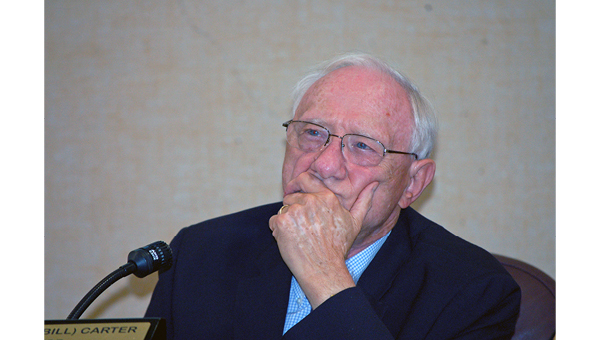Militia Muster presents Colonial-era skills, trades to visitors at Sycamore Shoals Park
Published 10:34 am Tuesday, February 17, 2015

Star Photo/ Abby Morris-Frye
Ethan Chipley, age 6, his mother Rachel Chipley and baby sister 8-month-old Juila Chipley, watch and listen as Interpretive Ranger Chad Bogart describes the different ways in which people wrote letters and how the postal service worked during colonial days.
Visitors to Sycamore Shoals State Historic Area took a step back in time over the weekend as the colonial days came to life through the skills and stories of historic reenactors.
On Saturday and Sunday, the state park presented Colonial Skills and Trades: Militia Muster at Fort Watauga. Scattered around the grounds of the fort were a variety of different reenactors and crafters, each telling a different tale or demonstrating a different skill.
Characters of all kinds — from hunters and farmers to land speculators and backcountry gentry — were all on hand for the event. Demonstrations in hide smoking, open hearth cooking, weaving, woodworking a variety of other colonial life skills were held during the weekend.
Trending
“Our main goal this weekend was to just show the different skills and trades people used in the 18th century,” said Chad Bogart, an interpreter at Sycamore Shoals State Historic Area.
Many of the skills demonstrated over the weekend may seem strange to people today, he added, but during the late 1700s those skills and crafts were needed for survival.
In addition to the skills and trades demonstrations, reenactors with the Washington County Regiment of the North Carolina militia were on hand for militia drills and performances by the Fife and Drum Corps.
“We always do the regular militia drills,” Bogart said. “We try to do that every time because that is what we represent is the frontier militia.”
During that period of time, Bogart said, all men from age 16 up to age 60 were required to serve in the militia.
In one corner of the fort, militia members Kim Palmer and Bucky Claybaugh stood around a stove and pipe operation used to smoke hides. Smoking was one of the ways used to tan hides during that time period, Palmer said.
Trending
“We get a better color and it also strengthens the hides to smoke them,” Palmer explained to a group of Milligan College students who were on a class outing to the event.
Both Palmer and Claybaugh had a variety of tools and weapons attached to their costumes and explained the use and purpose of each one, if asked.
“We just try to do a little living history,” Palmer said.
Inside one of the cabins, Ramona Ato worked to keep a fire going as she demonstrated open hearth cooking.
“I’ve been cooking on a hearth for about 10 years,” she said. “You burn a lot of food learning, but you eventually get a sense of the timing.”
Lisa Bennett was also busy cooking. As she mixed and kneeded dough by hand, she already had two dutch ovens containing biscuits cooking away on the hearth. Over the fire, hung a pot of beans and a skillet filled with sausages sizzled on the hearth.
Bogart gave demonstrations on letter writing using various kinds of ink and lead pencils as well as explaining how the postal service worked during the late 1700s.
Rachel Chipley, of Roan Mountain, and her children, Ethan, 6, and Julia, 8 months, watched as Bogart used wax to seal a document.
“We’ve never been before so we thought we would check it out today,” Chipley said.





